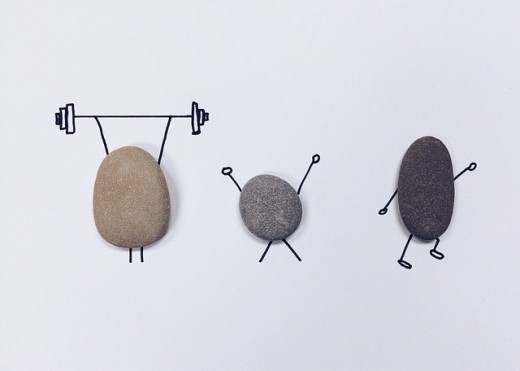How Much Training Do I Need to Not Die in the Attempt?

How Often Should We Workout?
To begin with, remember that everyone is different. There is no a magic formula that is right for each person. In the event that you wish to improve your fitness level, the number of days per week will depend on how active you are already.
For instance, if you have never worked out before, you will probably see results by training only once per week. However, if you are used to workout at the gym multiple times every week, your body will not feel challenged enough to make new gains or just to stay in peak form.
In general, to improve your fitness and stay in shape, 4 to 5 days per week will do the trick. But as I mentioned before, everything will depend on the individual goals. For example, in the scenario that you are hitting the full five days per week, three of them should be focused on strength training, two on cardio and the last two in active rest. However, you should think about your goals if you are able to workout for fewer days.
The Hepburn Approach
Nowadays, there are different approaches to training. It is important to try different viewpoints until you find the one that fits your needs. One of these approaches I have been following is the one from Doug Hepburn. He was one of the strongest people who won weightlifting gold medals during the 50's. He strongly believed in recovery principles to get results, and had a very simple perspective on training.
- How often you workout will depend on your lifestyle. If your stress levels are high, the frequency will be 2 to 3 times per week. However, if your stress levels are low or moderate, the frequency can increase (up to 6 times per week).
- Mental training should be included in your weekly training. By focusing on a relaxation program, your recovery process will improve, as well as, your strength. Doug knew that we get stronger after training. Not during it.
There are hundreds of websites out there where you can find the programs of Doug Hepburn. If you are interested, just look for the one that might suit you!
Are Your Fitness Goals S.M.AR.T Enough?
There are thousands of sites that will help you to set your fitness goals. By doing some research, I found that one of the best ways to define goals is by writing them down explaining in detail what exactly we need to do. These types of goals are well known as S.M.A.R.T, which is an acronym for Specific, Measurable, Attainable, Relevant, and Time-bound. In short, you will need to answer the following questions:
Specific: What do you exactly want to accomplish?
Measurable: How will you measure your progress?
Attainable: Is your goal reasonable?
Relevant: Is it realistic?
Time-bound: Have you set a deadline?
S.M.A.R.T Goal Example 1. Lose pounds
- Specific: I will lose weight
- Measurable: I will lose 7% of my body weight
- Attainable: It has been proved that losing 5-10% of body weight is attainable for most overweight people.
- Relevant: I will lose 7% of my body weight to feel good about my image.
- Time-bound: I will lose 7% of my body weight in 3 months
Now, you need to set a plan in order to achieve your goal. An example of this will be:
- Walk 6 days per week at least 30 minutes each.
- Bring lunch to work 4 days per week. Reduce eating outs to once per week.
- Drink water every day instead of soda.
S.M.A.R.T Goal Example 2. Improve athletic skills
- Specific: I will master a martial art
- Measurable: I will get my black belt in Aikido (Japanese martial art)
- Attainable: In Australia, people can grade every 3 months.
- Relevant: I will get my black belt to be able to teach others.
- Time-bound: I will get my black belt in 3 years
A good plan to achieve this goal will be:
- Train at least 3 times per week the first 3 months. Then, increase to 4 to 5 times per week for the next year. Finally, train at least 6 times per week the last year.
- Read about aikido techniques and philosophy once per week
- Include vegetables in my lunch and dinner meals
Do You Want to Start a Running Program? Set Your Goals First!
Workout Frequency Recommendation
Personally, I workout up to 5 days per week. Therefore, I would like to share my own training frequency recommendation:
Strength Training: 2 to 3 Times Per Week
If you are working out 4 to 5 times per week, you should incorporate strength training 2-3 times in your training plan. This is because The more muscle you have the higher your metabolic rate.
This means that you will burn out more calories when you are not exercising.
You need a balance between pulling and pushing exercises and include upper and lower body moves. You will perform different movements in each strength training sessions but repeat them weekly. One recommendation is to stay with the program for 3 to 4 weeks and increase weight progressively.
Strength training will make you stronger. Its main benefits are the following:
- Maintains balance and flexibility.
- Protects muscle mass and bone health.
- Manages your weight
- Decreases risk of injury.
- Manage your pain
- Improves posture.
- And so on...
Some examples of strength training are resistance bands, free weights, your own body weight, medicine balls, and weight machines.
Cardio Workout: 2 to 3 Times per Week
Cardio is an important part of your training routine. You will recover very fast as it will maintain your circulatory system working optimally. Other benefits of include cardio in your workout routine is that it increases your VO2 max, helping your body utilize oxygen and also it keeps your endurance up.
Some examples of cardio options are:
- Running. It is especially good for strengthening your core muscles.
- Cycling. This kind of exercise will help you to strengthen your hips, thighs, and rear end.
- Rowing. It is mainly beneficial for your upper-Body
- Elliptical training. An elliptical machine can work your upper and lower body at the same time.
- Functional Movements. Functional training focuses on movements and not necessarily on muscles. It helps to build power, mobility, and strength. An example of this kind of exercise is the kettlebell swings.
- HIIT workouts. It is good to stay in shape and it has good post-workout effects. It helps to increase your body metabolism.
- Tabata Cardio workouts. The main benefits of this type of workout are fat loss, muscle preserving, squats, push-ups.
- And so on.
Rest Days: 2 Times per Week
Including rest days in your routine lets your body recover and recharge. In this way, you would be able to get back to your workouts refreshed. As a general rule, a rest day should be an active recovery. You do not necessarily need to sit on your couch all day!
You don’ need to go to the gym either. However, you could do something that you really enjoy. This will help to recover physically and mentally. Some examples of an active recovery day are: taking a walk, yoga class, light jogging, pilates, and meditation. Even swimming can be considered a "rest day" activity. It will depend on your fitness level.
Workout as Much as You Need. Then, Relax!

© 2018 Mercy Blanco








